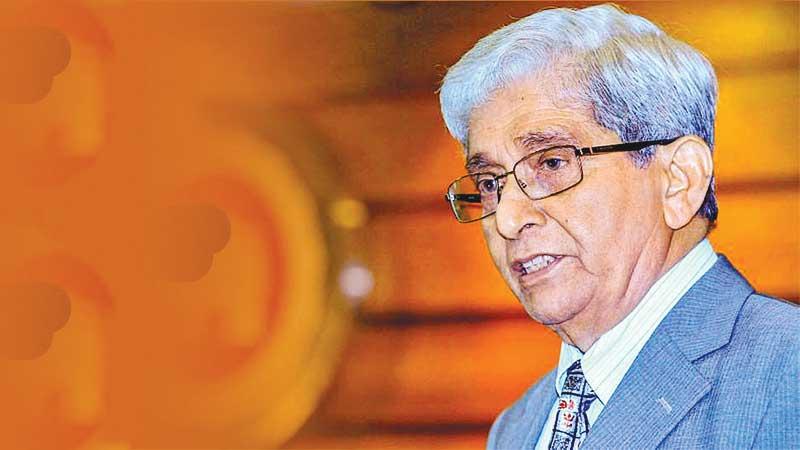
The focus of the Government and the Central Bank is to make Sri Lanka a debt-free economy in the future by managing domestic and foreign debt well, Central Bank Governor Prof. W.D. Lakshman told the media on the Monetary Policy stance of the Bank on Thursday.
However, he said that does not mean the country would be a debt-zero economy.
“The focus will be on enhancing the performance of the real sectors of the economy such as promoting exports and developing the agriculture, services and industrial sectors,” he said.
Statistics, however, reveal that the trade deficit had widened with an increase in imports in relation to exports this year.
In spite of the resilience shown by merchandise exports, the trade deficit widened from January to May this year over the corresponding period last year.
Speculation of a program with the International Monetary Fund (IMF) were refuted by the governor.
Sri Lanka will receive around USD 800 million under Special Drawing Rights provided to member states by the Fund. As of end June the gross official reserves stood US dollars 4.0 billion (equivalent to 2.7 months of imports) which does not include the bilateral currency swap facility with the People’s Bank of China (PBoC) of CNY 10 billion (equivalent to approximately US $ 1.5 billion).
However, the regulator expects growth in the first quarter this year to be higher than the initial forecast and overall GDP growth this year to be around five percent due to the vaccination drive and the recovery in economic activities. The Central Bank notes that the economy is likely to have recorded a higher than expected growth rate in the first quarter of 2021 although GDP estimates for the first quarter this year have not been released by the Department of Census and Statistics.
The bank noted that indicators for several key sectors of the economy point towards a stronger than expected recovery during the quarter.
“We could expect a higher growth rate in the first quarter this year due to the all time high performance in the industrial sector, “ Director, Economic Research Central Bank, Dr. Chandranath Amarasekera said.
Disturbances to domestic economic activity due to the third wave of the pandemic and related preventive measures weakened the recovery somewhat, in the second quarter of 2021.
Nevertheless, the ongoing vaccination drive throughout the country and the likely removal of mobility restrictions are expected to ease the impact of the current wave of Covid-19 on overall economic activity, thereby facilitating a sustained economic recovery towards achieving a GDP growth rate of around 5 per cent in 2021.
Along with the expected recovery in the global economy and the improvements on the domestic front, the upward momentum of economic activity is envisaged to sustain over the medium term. The external sector is expected to gradually recover in the period ahead
Challenges emanating from multiple waves of Covid-19 globally and domestically continued to stifle the recovery of the tourism industry.
On the other hand, the notable improvement in workers’ remittances continued to provide support for the external current account. While the measures introduced to address challenges in the external sector have helped ease the domestic foreign exchange market conditions to some extent, speculative behaviour and frontloading of imports have caused undue pressures in the market.
The exchange rate has recorded a depreciation of 6.7 percent against the US dollar thus far during the year.
Although the level of foreign reserves could experience some variations in the period ahead, such developments are expected to be temporary, with the adequate financing strategies lined up to maintain reserves at sufficient levels and to meet all maturing debt servicing obligations of the Government on time.
Market interest rates remain low, facilitating increased credit flows to the private sector In response to the monetary policy easing measures adopted by the Central Bank, most market deposit and lending interest rates have declined to their historic low levels.
Prevailing low interest rates and the surplus rupee liquidity in the domestic money market enabled the flow of low cost credit to the economy, thus supporting the revival of economic activity.
Credit extended to the private sector expanded notably during the period from January to May 2021, and this momentum is expected to sustain through 2021.
The Central Bank expects domestic investors to make use of the low interest rate environment to expand their productive economic activities and explore new opportunities that are being created in the economy aimed at local and international markets.
Any buildup of sustained inflationary pressures will be addressed through appropriate measures over the medium term Inflation remains moderate, given the subdued aggregate demand conditions, although food inflation has accelerated due to supply-side disruptions. Inflation is expected to remain broadly within the desired 4-6 per cent range during the remainder of 2021.
The envisaged improvements in aggregate demand conditions stemming from the effects of the stimulus measures adopted by the Central Bank and the Government and the likely increases in global commodity prices, may generate some inflationary pressures over the medium term.
Such pressures will be mitigated through timely policy intervention by the Central Bank, thereby ensuring the maintenance of inflation in mid-single digit levels over the medium term.
The Monetary Board decided to maintain the policy interest rates, i.e., Standing Deposit Facility Rate (SDFR) and the Standing Lending Facility Rate (SLFR) of the Central Bank, at their current levels of 4.50 percent and 5.50 percent.
The Central Bank will continue to monitor domestic and global macroeconomic and financial market developments and stand ready to take appropriate measures, as and when necessary, with the aim of maintaining inflation in the targeted 4-6 per cent range under the flexible inflation targeting framework in the medium term, while supporting sustained economic recovery.
